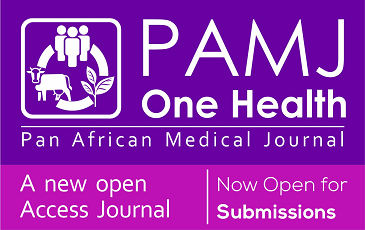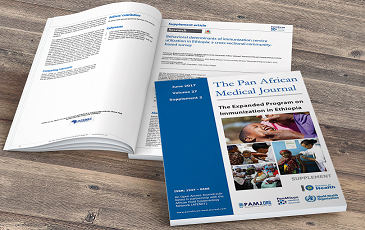Advanced abdominal pregnancy with intestinal obstruction: a case report
Lusajo Mwagobele, Rabson Bagoka, Frank Martin Sudai, Lameck Mdengo, Godbless Kimaro Nelson, Andrew Aman Magomba, Stanley Zakaria Binagi, Emanuel Michael, Edson Revocatus
Corresponding author: Lusajo Mwagobele, Ministry of Health, Maweni Regional Referral Hospital, Kigoma, Tanzania 
Received: 26 Aug 2024 - Accepted: 16 Oct 2024 - Published: 27 Mar 2025
Domain: Radiology,Obstetrics and gynecology,Surgical Sciences
Keywords: Abdominal pregnancy, methotrexate, intestinal obstruction, ectopic pregnancy, case report
©Lusajo Mwagobele et al. PAMJ Clinical Medicine (ISSN: 2707-2797). This is an Open Access article distributed under the terms of the Creative Commons Attribution International 4.0 License (https://creativecommons.org/licenses/by/4.0/), which permits unrestricted use, distribution, and reproduction in any medium, provided the original work is properly cited.
Cite this article: Lusajo Mwagobele et al. Advanced abdominal pregnancy with intestinal obstruction: a case report. PAMJ Clinical Medicine. 2025;17:27. [doi: 10.11604/pamj-cm.2025.17.27.45125]
Available online at: https://www.clinical-medicine.panafrican-med-journal.com//content/article/17/27/full
Advanced abdominal pregnancy with intestinal obstruction: a case report
![]() Lusajo Mwagobele1,&, Rabson Bagoka1,
Lusajo Mwagobele1,&, Rabson Bagoka1, ![]() Frank Martin Sudai1, 2, Lameck Mdengo1, Godbless Kimaro Nelson1, Andrew Aman Magomba1, Stanley Zakaria Binagi1, Emanuel Michael1, Edson Revocatus1
Frank Martin Sudai1, 2, Lameck Mdengo1, Godbless Kimaro Nelson1, Andrew Aman Magomba1, Stanley Zakaria Binagi1, Emanuel Michael1, Edson Revocatus1
&Corresponding author
Abdominal pregnancy is a rare type of ectopic pregnancy (1%) with life-threatening potential to both mother and fetus. We present a 17-year-old female G2P1L0 at term; with previous scar and a history of failed intracervical catheter induction before being referred to our facility, who sought medical attention due to complaints of absent fetal movements, fever, and obstipation persisting for three days; unfortunately, antenatal care did not include obstetric ultrasound assessments. Physical examination revealed a transversely positioned baby without an appreciable fetal heart rate. Ultrasound imaging confirmed extrauterine pregnancy, while X-ray findings indicated dilated bowels with the fetal spine in a transverse orientation and head not occupying the pelvis. Emergency laparotomy successfully extracted a macerated baby from the abdominal cavity, with the placenta left in situ. The postoperative course was uneventful. This case underscores the importance of obstetric ultrasound in antenatal care to detect and prevent abdominal pregnancy complications.
Abdominal pregnancy is a rare condition, constituting approximately 1% of all ectopic pregnancies, where a fertilized egg implants outside the uterus either initially or subsequently and represents 1 in 10,000 live births [1]. The most frequent sites for implantation in abdominal pregnancy are the pelvic peritoneum, followed by the uterine serosa, bowels, and omentum. The least common occurrences are in the liver, spleen, and retroperitoneal area [2]. We report a case of a 17-year-old pregnant female with a history of failed induction who presented with symptoms of intestinal obstruction secondary to abdominal pregnancy confirmed with an ultrasound and X-ray imaging, followed by successful emergency laparotomy.
Patient Information: a 17-year-old female peasant, G2P1L0 at 37 weeks gestation by date, was referred to our facility following unsuccessful intracervical catheter induction due to fetal demise. She presented with a gradual onset of intermittent high-grade fever, sudden cessation of fetal movements three days prior, and complaints of obstipation, abdominal pain, and swelling. The patient denied experiencing vomiting, nausea, difficulty swallowing, or any history of trauma. Antenatally, she initiated care at 14 weeks gestational age, attending three uneventful visits with exception of the absence of obstetric ultrasound assessments. Her obstetric history included a previous cesarean section two years ago, with the neonate passing away at three days old due to pneumonia. There were no reported instances of dyspareunia, abnormal vaginal discharge, or use of intrauterine copper devices.
Clinical findings: during the examination, the patient displayed alertness but was dehydrated, exhibiting dry mucus. She presented with a fever, with a temperature of 38.5°C, and maintained normotensive blood pressure. Abdominal distension was noted to be asymmetrical, moving with respiration, and tender upon palpation. The fetus was observed in a transverse lie position with no detectable fetal heart rate. The cervix was found to be posteriorly positioned, tip of finger dilatation, thick, and showed no signs of effacement.
Timeline of current episode: admitted on August 2, 2024, and underwent an emergency exploratory laparotomy, then discharged on August 12, 2024.
Diagnostic assessment: complete blood count revealed leukocytosis (WBC 12), hemoglobin 10.6 g/dL, and platelets 335,000/μL. Electrolyte levels were within normal limits, Malaria Rapid Test was negative. Renal function tests were normal (BUN 3.2 mg/dL, creatinine 50 μmol/L). Blood type was B positive. Abdominal and pelvic ultrasound demonstrated an empty uterus with a normal endometrial stripe (Figure 1). An extrauterine fetus was visualized in a transverse lie, with no detectable fetal heart rate or movement. Abdominal X-ray showed dilated bowel loops with the fetus positioned transversely, and the head not engaged in the pelvis (Figure 2).
Diagnosis: intestinal obstruction secondary to advanced abdominal pregnancy and sepsis.
Therapeutic interventions: placement of a nasogastric tube was done to decompress, along with a urinary catheter and two large-bore cannulas. Resuscitation was initiated with Ringer's lactate and dextrose + normal saline. Antibiotics were promptly administered, including ampiclox IV 1g QID, metronidazole IV 500mg TDS, and paracetamol IV 1g TDS. Heparin SC 5000IU OD was also administered. These medications were continued for seven days before transitioning to oral medications for the other 5 days. An emergency laparotomy was conducted, during which a macerated fetus without an amniotic sac was discovered upon opening the peritoneum (Figure 3). The baby was delivered, and the umbilical cord was secured with two ties using vicryl suture. The placenta, positioned at the antero-lateral aspect of the uterus (Figure 4), was deliberately retained in place to mitigate the risk of excessive bleeding. Following weighing, the macerated baby was found to weigh 3.0kg (Figure 5). The abdomen was closed in layers. Postoperative orders were followed. A single packed red blood cell transfusion was administered, along with methotrexate 30mg orally STAT to facilitate placental degeneration.
Follow-up and outcome of interventions: before discharge, the wound was assessed and found to be dry, with no fever spikes or abdominal distension. Flatus was passed 24 hours after the exploratory laparotomy, and oral sips were commenced. The patient gradually progressed to soft stools, and no complications occurred. Two weeks after being discharged, a follow-up appointment at the outpatient clinic revealed grade III placenta calcification on a pelvic ultrasound.
Patient perspective: “I am grateful for the attentive care I received and the detailed explanation of my condition. I feel fortunate to be alive and am appreciative of the medical team's efforts. Moving forward, I am committed to prioritizing my health and the health of my future pregnancies. I plan to take proactive steps, such as scheduling obstetric ultrasounds early in my pregnancy and seeking prompt medical attention, to ensure comprehensive care and a positive outcome for myself and my baby”
Informed consent: an informed consent was obtained from the parents.
Abdominal pregnancy in the field of management can be categorized as either early (occurring at or before 20 weeks gestational age) or advanced (presenting at diagnosis after 20 weeks gestational age) [2]. In the course of an advanced abdominal pregnancy, the majority of cases (about 80%) involve maternal hemorrhage that necessitates a blood transfusion. Additionally, fetal mortality rates can reach as high as 72%, with fetal morbidity ranging from 20-40%. The fetal complications typically arise from compression and a deficiency of amniotic fluid [3]. Early abdominal pregnancies may not show any symptoms or signs, but they are more likely to be present in advanced cases. These symptoms can include palpable fetal parts, abdominal pain, and failed induction of labor, as in this case report, before being referred to our facility for further treatment [2]. Ultrasound examination can be used to establish the diagnosis, with sonographic findings such as an empty uterus and the absence of myometrium between the fetus and the maternal abdominal wall, as seen in this case report. Magnetic resonance imaging (MRI) can also be used as an adjunct to ultrasound to precisely locate the placenta and its blood supply about the surrounding structures. However, in this case, an MRI was not performed due to its unavailability [2,4].
In low-resource settings, abdominal pregnancies are often detected at a later stage compared to higher-resource settings. In such settings, where red blood cell transfusions may not be readily available, it has been suggested that the placenta may be left in situ after the fetus has been removed [5]. This was done in the case presented, followed by the administration of methotrexate to facilitate placental degeneration. Methotrexate aims to destroy trophoblastic cells, reduce the placenta's blood supply, and promote its absorption [6]. Highlighting the importance of prompt management is essential when dealing with abdominal pregnancy. Utilizing strategies like surgical exploration, removal of the abdominal pregnancy, and managing bleeding are crucial in reducing the chances of complications, such as hemorrhagic shock. Early intervention, along with a collaborative effort from obstetricians, surgeons, and anesthesiologists, is vital in improving patient outcomes [7].
In the process of receiving antenatal care, it is important to accurately establish the position of the pregnancy, rather than solely relying on a Urinary Pregnancy Test to confirm its existence. Regular ultrasound examinations should be conducted during prenatal appointments and particularly when contemplating labor induction. This is critical for safeguarding the health and welfare of both the expectant mother and the growing fetus.
The author declares no competing interest.
Management of patient: Lusajo Mwagobele, Rabson Bagoka, Emanuel Michael, Edson Revocatus, Lameck Mdengo, Godbless Kimaro, and Andrew Aman. Data collection: Lusajo Mwagobele. Manuscript drafting: Lusajo Mwagobele. Manuscript revision: Frank Martin Sudai, Lusajo Mwagobele, and Stanley Zakaria Binagi. All the authors have read and agreed to the final manuscript.
The authors extend their heartfelt thanks to the patient and her spouse for allowing them to share the medical information in this publication.
Figure 1: ultrasound image demonstrating an empty uterus with a thin endometrial strip
Figure 2: supine abdominal-pelvic X-ray showing dilated bowel loops, a transverse lie fetus, and no engaged head in the pelvis
Figure 3: intraoperative image after opening the peritoneum, revealing a fetus without an amniotic sac
Figure 4: intraoperative image showing the uterus in situ with the placenta located at the antero-lateral aspect
Figure 5: macerated baby weighing 3.0 kg with a deformed left limb due to compression
- Martin JNJ, Sessums JK, Martin RW, Pryor JA, Morrison JC. Abdominal Pregnancy: Current Concepts of Management. Obstet Gynecol. 1988 Apr;71(4):549-57. PubMed | Google Scholar
- UpToDate. Abdominal pregnancy. Accessed December on 31, 2023.
- Huang K, Song L, Wang L, Gao Z, Meng Y, Lu Y. Advanced abdominal pregnancy: an increasingly challenging clinical concern for obstetricians. Int J Clin Exp Pathol. 2014;7(9):5461-5472. PubMed | Google Scholar
- Mamo A, Adkins K. Abdominal Pregnancy: Pathophysiology, Diagnosis, and Treatment. J Gynecol Surg. 2022;38(3):193-196. Google Scholar
- Oneko O, Petru E, Masenga G, Ulrich D, Obure J, Zeck W. Management of the placenta in advanced abdominal pregnancies at an East african tertiary referral center. J Womens Health 2002. 2010;19(7):1369-1375. PubMed | Google Scholar
- Xu L, Xiang Z, Wu T, Feng S. Advanced Abdominal Pregnancy with Retained Placenta and Methotrexate-Induced Severe Bone Marrow Suppression: A Case Report. Biomed J Sci Tech Res. 2019;19(4):14487-14488. Google Scholar
- ELmiski F, Ouafidi B, Elazzouzi E, Elquasseh R, Lamrissi A, Fichtali K et al. Abdominal pregnancy diagnosed by ultrasonography and treated successfully by laparotomy: Two cases report. Int J Surg Case Rep. 2021;83:105952. PubMed | Google Scholar










